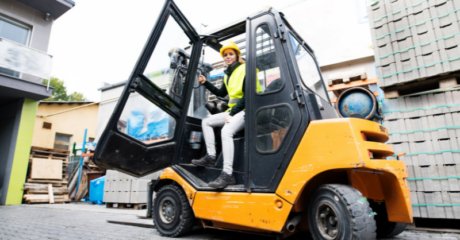
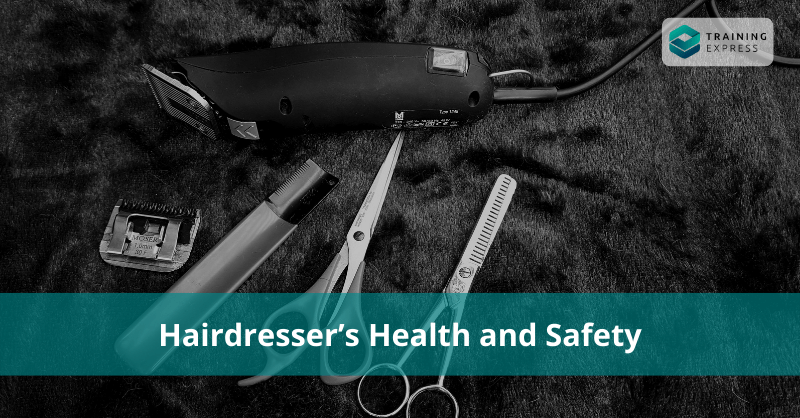
Everyone wants a good hair day! By cutting and styling people’s hair, you can make them feel much better and confident. However, it’s important that you encounter a few safety issues while running your salon. So, maintaining a hairdresser’s health and safety is paramount in every salon or barber shop.
By following the safety rules, you can protect your clients, employees, and the business by following safety rules. Besides, you can keep your salon hazard free and stay insured against potentially expensive legal actions. So, go through this Health and Safety blog for hairdressers and see what you should cover in your Hairdresser’s Health and Safety policy.
Table of Contents
What Does a Hairdresser Do?
Hairdressers are beauty care experts who provide consultations on hairstyling options. Their core duties include the following:
- Advise clients on hair care
- Shampoo and condition hair
- Cut hair with scissors, clippers or razors
- Provide various services such as colouring, bleaching, tinting and straightening
- Style hair with various equipment, such as brushes, combs, curlers, flat irons, etc
- Offer receptionist services, such as answering phone calls, making appointments and maintaining client records
- Sell salon/retail products
- Clean the work area and sterilise hairstyling equipment
- Supervise trainees and apprentices
- Deal with challenging clients
- Keep up with the trends
- Take measures to prevent shoplifting
In today’s digital era, efficiently managing appointments and client records is crucial for a salon’s success. Utilizing a sophisticated salon booking app not only streamlines these tasks but also enhances the overall client experience. To discover a top-rated solution, visit the salon booking app.
What Are Some Health and Safety Issues for Hairdressers?
There are various health and safety hazards that hairstyling work can cause, such as:
Chemical hazards
Many hair products contain harmful chemicals, such as hair dyes, permanent straightening creams and permanent wave solutions. These chemicals can threaten a hairdresser’s health and safety. For instance, daily exposure to those chemicals can cause skin problems and other diseases, including cancer.
Biological hazards
Hairdressers can be exposed to many biological hazards, such as bacteria, fungi, and viruses. These can be harmful to health as they cause infections and diseases.
Ergonomic hazards
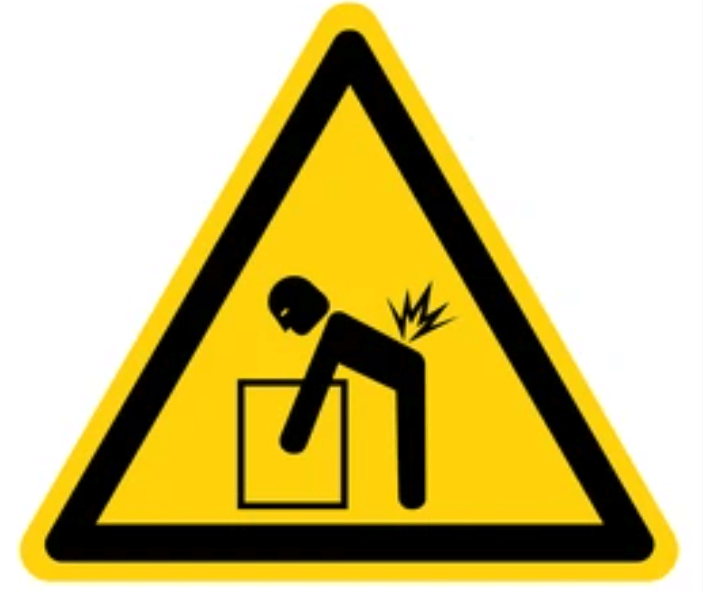
Hairdressing works are related to ergonomic hazards. For example, standing for long hours and working on awkward postures can harm a hairdresser’s musculoskeletal system. Also, hairdressers have to lift, carry and handle heavy objects at work, which can lead to sprains, strains and other injuries.
Psychological hazards
Working overtime and not having adequate breaks can cause psychological distress in hairdressers. On top of that, exposure to workplace violence makes hairdressing stressful.
Safety hazards
There are various safety hazards hairdressers have to encounter. For example, there are risks of cuts from razors, burns from flat irons, blow dryers and curlers. Also, wet and untidy floors can cause slips, trips and falls.
What are Some Preventive measures for a Hairdresser?
Every salon worker must have a good understanding of the standard operating procedures and safety precautions. Here’s how to stay protected from the various hazards in salons:
Chemical hazards
Hairdressers are exposed to many chemical hazards on a daily basis. Below are the precautions to control the salon’s chemical hazards and ensure the hairdresser’s health and safety.
- Identify the products that contain hazardous chemicals and label them appropriately.
- Try to use safer products.
- Go through the manufacturer’s instructions on how to use the product and develop appropriate controls.
- Avoid products that have cancer-causing ingredients.
- Educate staff about the proper use, storage and disposal of products.
- Use local exhaust ventilation to reduce exposure to hazardous fumes.
Biological hazards
The biological hazards that can threaten a hairdresser’s health and safety include bacteria, viruses and fungi. So, consider the safety precautions you may implement to lessen the likelihood that these threats will arise.
- Maintain proper hand hygiene to reduce the risk of infections.
- Clean the surfaces to remove any unwanted residues.
- Clean your hands before and after working with every client.
- Wear gloves for handling items or surfaces soiled with blood or body fluid.
Ergonomic hazards
Almost every hairdresser has to work in an uncomfortable posture and perform repetitive tasks. As a result, ergonomic issues are prevalent among hair salon workers. See what you can do to work ergonomically in a salon.
- Design a healthier, ergonomic salon for clients and employees.
- Provide adjustable stools and chairs, lightweight hair equipment and workbenches. Besides, use padding on the floor and raise the height of the workstations.
- Take breaks during work hours. Meanwhile, get your team to walk about or stretch whenever possible to prevent muscle stiffness.
- Ensure job rotation to avoid overuse injuries
- Buy hairdressing tools (scissors, clippers, blow dryers, etc.) that are easy to use.
- Store heavy and frequently used materials at waist height.
Psychological hazards
Hairdressers have to face many challenges everyday that can affect their psychological well being. For instance, excessive work pressure and dealing with demanding clients can cause daily stress and anxiety.
Below we’ve discussed how to overcome psychological issues in hair salons:
- Try to maintain a balanced workload.
- Respect all employees and treat them fairly.
- Get all employees involved in the decision-making process. Then, let them share their ideas. Therefore, they’ll feel their opinions are valued and trusted.
- Train them on Mental Health awareness to reduce the stigma of mental illness.
Safety hazards
Cuts, bruises and burns are the most common safety issues faced by hairdressers. Therefore, taking safety precautions is paramount to minimise the risk of injury.
Here we’ve discussed the preventive measures for a hairdresser’s health and safety:
- Make sure the hairdressing tools are functionally ready and safe to use.
- Read the manufacturer’s instructions on how to use appliances safely.
- Ensure safe disposal of all sharp equipment.
- Wash and disinfect all hairdressing equipment after each use.
- Clean the floors of your salon at regular intervals.
- Ensure proper lighting in every room.
- Take electrical safety precautions.
- Train employees on Electrical and Fire Safety.
- Make a first aid kit to prevent injuries from worsening.
Personal Protective Equipment
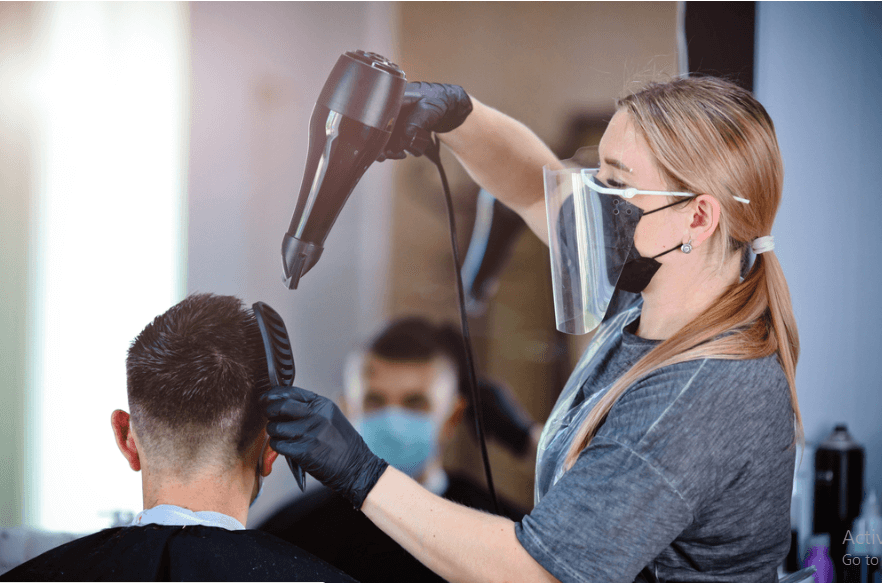
Hairdressers are often in direct contact with client hair, skin and chemicals. Also, they come in contact with blood and body fluids. As a result, infections can occur from such hairdressing procedures. However, PPE is a barrier to keeping hairdressers and their clients safe from diseases and injuries.
Here are the types of PPE every salon will need
- Face shields
- Disposable Gloves
- Aprons/gowns
- Hygiene Screens
- Shoe covers
- Headcovers
- Masks
- Respirators
- Eye protection
- Goggles
- Hand Sanitisers
What are some good general safe work practices?
Hairdressers are at risk of many health conditions. Therefore, they must be aware of the safe work practices to eliminate risks at work.
The following are some things to consider while working at a hair salon:
- Take extra precautions for hair products and equipment.
- Ensure everyone is secured from the risk of fire and electrical incidents.
- Educate all workers on safe Manual Handling.
- Practice good housekeeping in the workplace.
- Use, maintain and store PPE as per the manufacturer’s instructions.
- Have good First Aid knowledge.
- Follow the rules for salon safety.
- Practice proper hygiene.
Hairdressing Health and Safety Legislation
Most hairdressers suffer from work-related injuries. However, various health and safety legislations affect a hairdresser’s health and safety. Below are some of the important ones:
Keeping your salon/barbershop safe
As a salon or barbershop owner, ensuring a safe working environment is your top priority. It leads to happy employees and satisfied clients.
Below are the safety steps for salons and barbershops:
- Ensure proper ventilation to protect the hairdresser and the client’s breathing zone. In addition, good ventilation helps control the ambient environment of chemical vapours, odours, and respiratory diseases.
- Check the gas and electrical appliances every day.
- Take appropriate measures to prevent slips, trips and falls.
- Check water regularly to manage legionella.
- Make sure you have fully functional and readily accessible smoke detectors, fire extinguishers, and fire drills. Then, again, have a clear evacuation plan to protect everyone in the facility.
Most Common Hairdresser’s Health and Safety Hazards
The beauty salon industry comes with many risks. For instance, people working in the industry are often exposed to hazards from chemical and physical factors. There are cuts, burns, work stress, and so much more. However, every business must take proper measures to ensure the hairdresser’s health and safety. Moreover, they must ensure that the company harms nobody else (For instance, clients, visitors, children, etc.)
Here are some health and safety risks for people in the salon industry and some guidance on ensuring a hairdresser’s health and safety.
Cuts from scissors
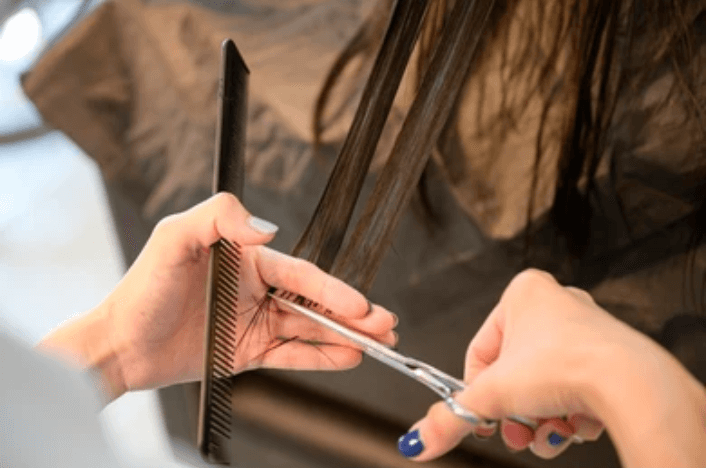
Scissors and razors can cut the skin. Therefore, they need to be used carefully.
- How are workers and others harmed?
- Both stylists and clients can be cut or nicked by accident.
- For stylists, having prolonged contact with water and chemicals can be irritating after a cut. Also, it may cause severe skin damage.
- For clients, an open wound can become infected or contaminated if proper sterilisation practices are not in place. Moreover, contaminated equipment can carry many infectious diseases, such as hepatitis B, hepatitis C and tetanus.
- What can you do?
As a hairdresser, following a few simple steps can prevent cuts and pains in the hands. Below are some examples:
- Keep scissors, razors, clippers and other sharp utensils in a safe place and good condition.
- Cover all sharp equipment when not used.
- Sharpen the equipment often, so they last longer and are safer to use.
- Sterilise all equipment after use.
- Ensure all equipment is trained in using the hairstyling equipment.
Harmful chemicals in hair products
Some hair care products contain toxic chemicals to give hair instantly satisfying results. As a result, hair dyes and other chemical hair products should be used and stored correctly to avoid the risks of exposure.
- How are workers and others harmed?
In hair salons, hairdressers have to work with a range of chemical hair products. They get exposed in several ways, such as:
- Skin contact
- Inhaling
- Eye contact
- What can you do?
- Try to use fewer toxic hair products
- Avoid decanting and mixing chemicals. Instead, buy chemicals in ready-to-use packages.
- Work with chemicals in a well-ventilated room.
- Patch-test all new products before you use them on clients
- When applying chemical hair products, cover clients’ exposed skin (neck and arms)
- Store chemicals following the instructions of the Safety Data Sheet (SDS)
- Train workers on first aid for chemical burns
- Have eye baths available to reduce chemical eye burns
Burns from chemicals and hairstyling tools
Curling irons, hair straighteners and hair dryers can cause painful and severe burns. Also, many other factors can cause skin burns and damage.
- How are workers and others harmed?
- Washing hair with very hot water
- Using various heated tools on hair
- Using chemical hair dyes or new products that aren’t patch-tested
- What can you do?
- Purchase heating irons and other heating tools that have good safety features. Also, make sure they turn off automatically after a set period.
- Maintain the temperature of hot water taps. In addition, check the water temperature every time before use. Again, you may ask your clients if they’re comfortable with the temperature.
- Use cages to store heated tools when turned on to avoid accidental touch with hot parts and burns
- Have good lighting in your salon. So, stylists can see and understand what they’re doing. Also, they can ensure their client’s safety.
- Take appropriate measures to treat burns and prevent them from worsening.
Back pain from poor work posture
Working long hours in an uncomfortable posture can put a hairdresser’s health and safety at risk. For instance, it can affect their physical health, and lead to increased neck, back and chest pain.
- How are workers and others harmed?
Hairdressers spend most of their day working on poor posture. They have to use both arms extensively for cutting and styling. As a result, they are at higher risk of body pain. On top of that, working long hours leads to job stress, exhaustion, and depression.
- What can you do?
- Hairdressers come in all sizes. As a result, equipment adjustment is necessary to avoid discomfort. So, provide adjustable furniture and equipment to make work easier.
- Use anti-fatigue mats to prevent accidents such as trips and falls
- Ensure stylists wear suitable footwear all day at the salon
- Ensure stylists know how to adjust chairs and other equipment to their needs.
- Train hairdressers in maintaining correct posture
Slips, trips and falls due to poor housekeeping
Wet and slippery floors, uneven surfaces and improper lighting can increase the risk of slips, trips and falls.
- How are workers and others affected?
Slips, trips and falls are the most common causes of injuries at work. In addition, they can cause sprains, strains, bruises and fractures.
Here are some of the causes of slips, trips and falls
- Wet and slippery floors
- Spilled hair products
- Leaking shampooing sink
- Exposed electrical wires
- Upswept hair clippings
- Poor housekeeping
- What can you do?
- Maintain good housekeeping
- Clean up water and spilled products quickly
- Use anti-slip mats in accident-prone areas
- Keep cables off the floor
- Store utensils and liquid products properly to avoid spillage
- Choose non-slip shoes for working
Contact dermatitis due to wet work and harmful chemical products
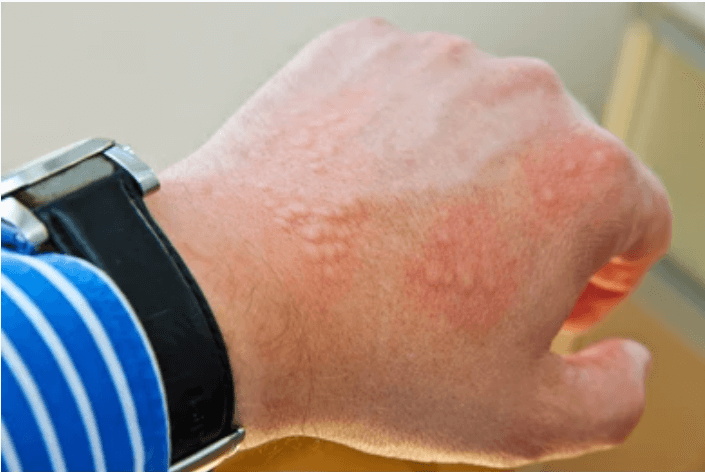
Hairdressers must do a lot of wet work, such as washing and colouring hair and handling chemical products. As a result, contact dermatitis can flare up through wet working and constant exposure to chemical hair products.
- How are workers and others harmed?
Hairdressers must regularly wash their hands with soap. They also come in contact with shampoos and many other harmful chemicals and cleaning products throughout the day. As a result, they are at high risk of contact dermatitis.
Contact dermatitis has two types: irritant contact dermatitis and allergic contact dermatitis.
Irritant contact dermatitis
Irritant contact dermatitis can occur due to extensive wet working or coming in contact with chemicals.
Allergic contact dermatitis
Hairdressers get allergic contact dermatitis by an allergic reaction to chemicals in hairdressing products, such as shampoos and hair dyes.
- What can you do?
- Wear disposable, non-latex gloves when shampooing, colouring and touching chemical products.
- Dry hands after washing
- Moisturise hands after washing
- Change gloves between clients to avoid contamination
- Avoid scratching irritated skin
- Have regular skin checks for dermatitis (for instance, itchy, blistered, dry and cracked skin)
Working in the salon alone
Lone workers are at a higher risk of stress and violent behaviour. In addition, some tasks may be challenging, and late-night shifts can hamper the health and safety of hairdressers.
- How are workers harmed?
Lone working can be physically and mentally challenging for stylists. For instance, workers have to use machinery and heavy loads that are difficult to carry out by one person. Likewise, it can be exceedingly difficult to work late-night.
- What can you do?
Employees must understand the problems workers face during lone working. So, they must carry out risk assessments to recognise any lone working risks related to the worker. Also, they should supervise lone workers and ensure a dedicated lone working safety policy for their well-being.
What Does COSHH Mean?
COSHH stands for Control of Substances Hazardous to Health. As hairdressers must work with harmful substances daily, a COSHH plan is required for employers to control hazardous substances sufficiently.
Every year, many salon workers are experiencing breathing or lung problems at work. As a result, it’s essential to carry out a COSHH risk assessment at every workplace.
Which Substances are Hazardous in a Hair Salon?
There are hazards in beauty salons, barber shops and almost every other workplace. These hazardous substances can have severe consequences for stylists.
Below are some hazardous substances in salons:
- Shampoos and conditioners
- Hair dye
- Hairspray
- Aerosols
- Henna products
- Cleaning chemicals and disinfectants
What Effects do Hazardous Substances Have on Health?
Exposure to hazardous substances can cause immediate health effects, such as
- Skin irritation or dermatitis from direct contact with the substance
- Infection from bacteria
- Asthma from exposure to dust or vapours
Controlling Dermatitis in Hairdressing
Dermatitis is a skin disease that occurs when the skin comes in contact with harmful substances. It causes the skin to become itchy, blistered, dry and cracked. Many hairdressers suffer from contact dermatitis. However, avoiding known allergens and irritants can help prevent occupational skin diseases.
COSHH in Hairdressing: Asthma
Hairdressers are exposed to many sanitising and irritative agents, such as dyes, bleaches and hair sprays. Hence, these workers can suffer from respiratory diseases, such as work-related asthma. Over time, it can cause long-term lung damage.
Here are some of the products that can cause occupational asthma
- Hair products
- Hairspray
- Cleaning chemicals
- Fumes from solvents and cleaners
- Dust from latex
- Henna products
How to Prevent Asthma in a Hair Salon
Asthma is an immediate threat to a hairdresser’s health and safety. Hence, asthma prevention is essential.
Below are the steps required for preventing asthma in a hair salon
- Improve air quality by ensuring good ventilation in the workplace.
- Reduce the exposure of toxic chemicals.
- Try to use pastes and solutions instead of dusty products, such as henna powder.
- Use liquid or gel cleaners instead of spray cleaners.
- Wear a face mask and keep a safe distance while using hair sprays on clients.
Prevention & Avoidance of Musculoskeletal Injuries
Musculoskeletal pain is a common complaint among hairdressers. But, a well-organised workplace can do wonders for them. Below are some safety precautions for a hairdresser
- Position equipment at comfortable locations to avoid bending and reaching
- Ensure hairdressers have enough working space to move about with ease
- Purchase size-adjustable furniture
- Take regular breaks
- Allow rotation and changing of tasks
Tips for Cleaning a Hairdressing Premises Safely
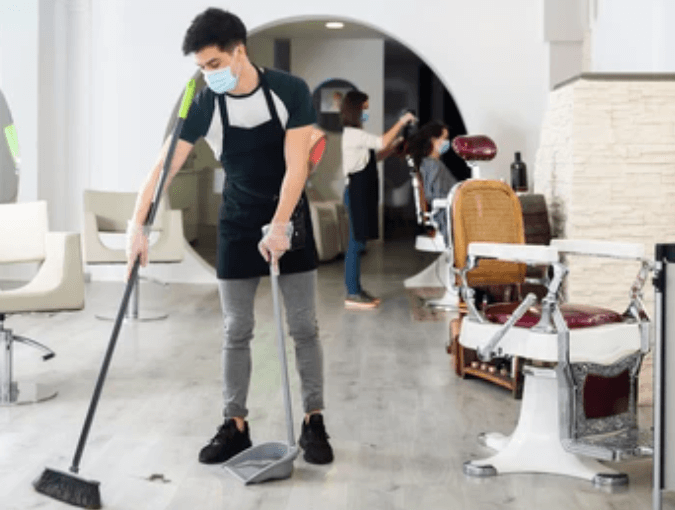
All furniture, equipment and surfaces should be cleaned and sanitised regularly at hair salons to prevent bacteria growth. As a result, you can maintain a high standard of hygiene in hair salons and promote a hairdresser’s health and safety.
Here’s what you can do to keep the salon clean and safe
- Maintain a clean and tidy work area.
- Clean up spills immediately.
- Wash out equipment after every use.
- Ensure safe disposal of chemical products.
- Clean and disinfect shower heads regularly.
- Wash and sanitise all equipment at the end of each day.
- Store equipment in dry conditions to stop bacteria growth.
Salon Safety Checklist
Workplace safety is of the utmost importance. A salon safety checklist can ensure that all necessary health practices are being followed for your salon staff.
Your salon safety checklist should include the following:
- Have a firm understanding of health and safety law and how it relates to your salon
- Conduct risk assessments
- Prepare a health and safety policy
- Train all workers in first aid
- Take measures to prevent dermatitis and musculoskeletal disorders among workers
- Ensure all salon equipment are safe for workers and clients
Summary
A hairdressing career comes with its demerits. However, following health and safety precautions will protect a hairdresser’s health and safety. Again, it will ensure the well-being of clients and the business.
To conclude, everyone working in salons must do everything possible to maintain a healthy, safer workplace.
- Available Courses
- Career Bundles74
- Animal care5
- Law8
- Quality Licence Scheme Endorsed111
- Teaching13
- Teaching & Academics Primary26
- Accounting & Finance Primary30
- Training3
- Design15
- IT & Software138
- Healthcare129
- Marketing31
- Health and Safety412
- Construction48
- Electronics25
- Hospitality22
- Health and Social Care234
- Child Psychology37
- Management379
- Business Skills270
- First Aid70
- Employability264
- Safeguarding75
- Food Hygiene103
- Personal Development1357
 Food Hygiene
Food Hygiene Health & Safety
Health & Safety Safeguarding
Safeguarding First Aid
First Aid Business Skills
Business Skills Personal Development
Personal Development






